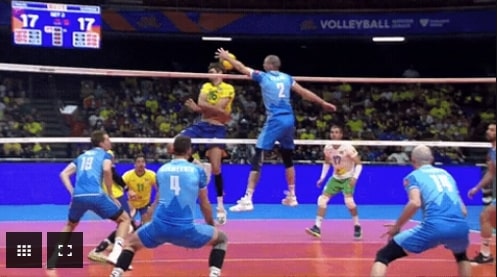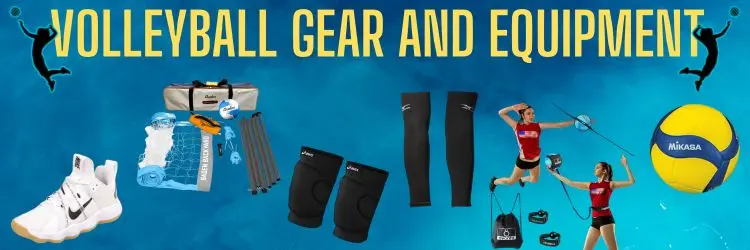Volleyball Blocking Rules

Volleyball Blocking Rules: Positioning, Contact Limitations and Regulations
Blocking is a crucial defensive skill in volleyball, allowing players to counter the opponent’s attack by deflecting or stopping the ball at the net. While blocking is an aggressive defensive move, it comes with strict rules that govern positioning, contact and player eligibility. These rules ensure fair play and maintain the balance between offense and defense.
This article will cover the fundamental blocking rules, including who can block, where players can position themselves, legal and illegal contact and strategic considerations for effective blocking.
What Is Blocking in Volleyball?
Blocking occurs when one or more front row players jump near the net to intercept or deflect an opponent’s attack. The goal is to prevent the ball from crossing the net or to slow it down, making it easier for teammates to defend. A successful block can result in an immediate point if the ball lands back on the attacking team’s side.
Who Is Allowed to Block?
Only front row players are permitted to block. This rule applies to both indoor and beach volleyball. The key eligibility rules include:
- Front row Players: Any player in the front row during a given rotation can attempt a block.
- Back row Players: Back row players are not allowed to block or attempt to block. If they do, it results in a fault and the opposing team gains a point.
- Liberos: The libero, a defensive specialist, is never allowed to block or attempt to block, regardless of their position on the court.
Positioning and Timing Rules for Blocking
Proper positioning and timing are essential for an effective block. However, certain regulations must be followed:
Reaching Over the Net
- A blocker is allowed to reach over the net as long as they do not touch the ball before the attacker has completed their hit.
- A blocker cannot interfere with the opponent’s play on their side of the net unless the ball is already traveling toward the blocker’s side.
- Exception: If the opposing team’s attack is weak or the ball is already in the blocking team’s space, the blocker can reach over and play the ball.
Net Violations
- Blockers cannot touch the net during a blocking attempt.
- If a blocker contacts the net while making a play, it is considered a fault and the opposing team is awarded the point.
- Incidental contact with the net may be allowed if it does not affect the play.
Interfering with the Opponent
- A blocker cannot place their hands or arms beyond the net in a way that prevents the opponent from executing their play.
- If a blocker hinders the setter or attacker’s motion, it results in a fault.
Contact Rules for Blocking
Blocking involves direct contact with the ball, but there are restrictions on how and when contact can be made.
Consecutive Contacts
- A blocker is allowed to touch the ball multiple times during the same blocking action, as long as it happens in a single motion.
- If a player blocks the ball and then immediately touches it again, it is considered one play, not a double hit.
- However, if another player from the same team touches the ball after the block, it counts as the first team contact.
Redirecting the Ball
- A blocker cannot catch, throw, or redirect the ball with prolonged contact.
- The ball must rebound off the hands immediately without excessive guiding or carrying.
Blocking a Serve
- Blocking a serve is illegal in both indoor and beach volleyball.
- Players must allow the serve to travel past the net before attempting a play.
Strategic Considerations in Blocking
While blocking is a defensive move, it can also be an offensive weapon when executed strategically. The following factors influence blocking success:
Timing and Anticipation
- A well timed block is more effective than simply jumping high.
- Reading the setter and anticipating the hitter’s angle helps block the ball successfully.
- Blockers must delay their jump slightly to react to the attacker’s swing.
Single vs. Double Block
- A single block is when one player attempts to block alone, typically used against quick attacks.
- A double block (or triple block) involves multiple players jumping together, creating a larger wall against powerful attacks.
- Teams must coordinate their positioning to close gaps between blockers and minimize openings for the hitter.
Hand Positioning
- Blockers should angle their hands toward the opponent’s court to direct the ball downward.
- Fingers should be spread wide to maximize surface area and reduce deflections.
- Blockers should aim to press over the net rather than just jump vertically.
Common Blocking Violations and Consequences
Blocking violations can result in the loss of a point or a side out. Some common mistakes include:
- Net Touch Violation: If a blocker touches the net during an attempt, the opponent is awarded a point.
- Back row Blocking Violation: If a back row player attempts to block, it results in a point for the opposing team.
- Over the Net Interference: If a blocker reaches over the net and interferes with an opponent’s set or hit, it is a fault.
- Blocking a Serve: If a blocker tries to stop a serve, the opponent is awarded a point.
- Illegal Multiple Contacts: If the blocker’s contact is prolonged or involves an illegal guiding motion, the point goes to the other team.
Differences in Blocking Rules: Indoor vs Beach Volleyball
While most blocking principles remain the same across indoor and beach volleyball, there are a few key differences:
| Rule | Indoor Volleyball | Beach Volleyball |
|---|---|---|
| Blocking Counts as a Team Hit | No | Yes |
| Blocker Contact with the Net | Any contact is a fault | Slight net contact may be allowed if it doesn’t interfere |
| Number of Blockers | Up to 3 blockers | Usually 1 or 2 due to smaller teams |
| Blocking a Serve | Illegal | Illegal |
In beach volleyball, a block counts as the first team contact, which means the team only has two more touches to return the ball. In indoor volleyball, a block does not count as a team hit, allowing for an additional contact.
Conclusion
Blocking is one of the most important defensive tactics in volleyball, but it comes with strict rules that players must follow. Only front row players can block and they must avoid net contact, illegal interference, or blocking a serve. Proper positioning, timing and coordination are essential for successful blocking. By mastering the rules and techniques of blocking, teams can strengthen their defense and gain a strategic advantage on the court.
Understanding these blocking rules ensures fair play while maximizing effectiveness in competitive volleyball. Whether playing indoors or on the beach, good blocking can disrupt an opponent’s offense and shift momentum in favor of the defending team.


